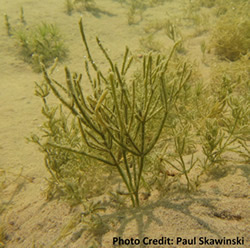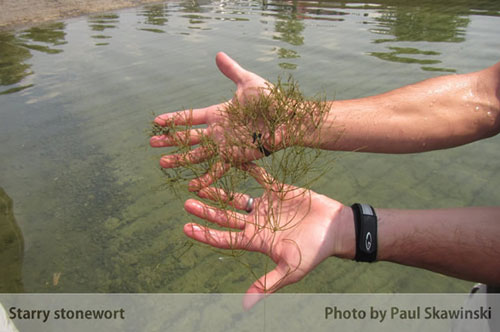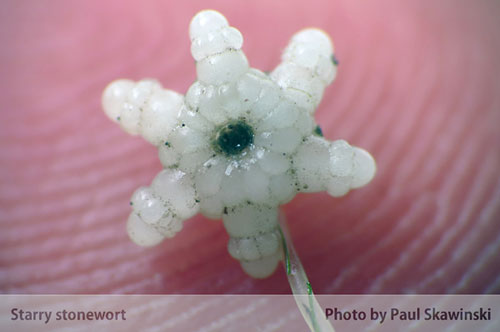Starry Stonewort
 Starry stonewort, a submerged annual macroalga, belonging to the order Charales (includes all Chara and Stonewort species), is known to cause nuisance conditions in MI, NY and IN. It can outcompete other vegetation and forms monotypic stands that can reduce fish spawning habitat. Starry stonewort, a submerged annual macroalga, belonging to the order Charales (includes all Chara and Stonewort species), is known to cause nuisance conditions in MI, NY and IN. It can outcompete other vegetation and forms monotypic stands that can reduce fish spawning habitat.Leaves: Whorls of 4-6 branchlets (leaves) with blunt tips, irregular length branchlets are arranged along the main thallus (stem) Fruits & seeds: Only male individuals in North America have been documented and reproduction is via fragments or vegetative structures called "bulbils" which is the main identifying characteristic. Bulbils are produced at nodes and most are found on the rhizoids. These bulbils are 3-6 mm wide, star-shaped with 5 or more points (see image below). Male specimen may produce orange-to –brown colored antheridia in branchlet axils. Control: Current control methods have not been shown to have a measurable impact on starry stonewort. Special care should be taken to reduce the spread of starry stonewort within and amongst waterbodies, and to educate the public about presence if it is found. |
||
|
 Starry stonewort, a submerged annual macroalga, belonging to the order Charales (includes all Chara and Stonewort species), is known to cause nuisance conditions in MI, NY and IN. It can outcompete other vegetation and forms monotypic stands that can reduce fish spawning habitat. Starry stonewort, a submerged annual macroalga, belonging to the order Charales (includes all Chara and Stonewort species), is known to cause nuisance conditions in MI, NY and IN. It can outcompete other vegetation and forms monotypic stands that can reduce fish spawning habitat.Leaves: Whorls of 4-6 branchlets (leaves) with blunt tips, irregular length branchlets are arranged along the main thallus (stem) Fruits & seeds: Only male individuals in North America have been documented and reproduction is via fragments or vegetative structures called "bulbils" which is the main identifying characteristic. Bulbils are produced at nodes and most are found on the rhizoids. These bulbils are 3-6 mm wide, star-shaped with 5 or more points (see image below). Male specimen may produce orange-to –brown colored antheridia in branchlet axils. Control: Current control methods have not been shown to have a measurable impact on starry stonewort. Special care should be taken to reduce the spread of starry stonewort within and amongst waterbodies, and to educate the public about presence if it is found. |
||
|




